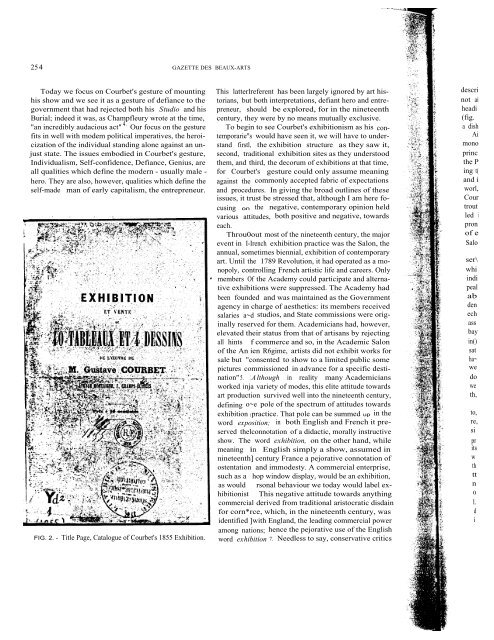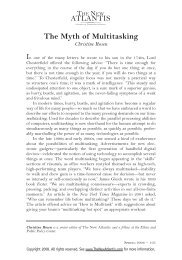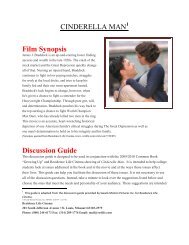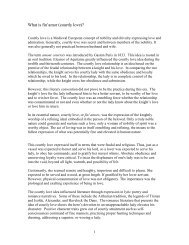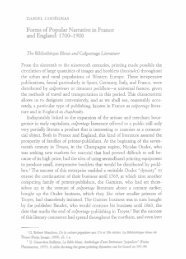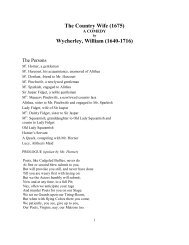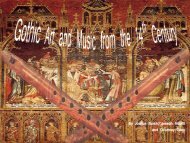Courbet's Exhibitionism
Courbet's Exhibitionism
Courbet's Exhibitionism
You also want an ePaper? Increase the reach of your titles
YUMPU automatically turns print PDFs into web optimized ePapers that Google loves.
254<br />
Today we focus on <strong>Courbet's</strong> gesture of mounting<br />
his show and we see it as a gesture of defiance to the<br />
government that had rejected both his Studio and his<br />
Burial; indeed it was, as Champfleury wrote at the time,<br />
"an incredibly audacious act" 4 . Our focus on the gesture<br />
fits in well with modem political imperatives, the heroicization<br />
of the individual standing alone against an unjust<br />
state. The issues embodied in <strong>Courbet's</strong> gesture,<br />
Individualism, Self-confidence, Defiance, Genius, are<br />
all qualities which define the modern - usually male -<br />
hero. They are also, however, qualities which define the<br />
self-made man of early capitalism, the entrepreneur.<br />
FIG. 2. - Title Page, Catalogue of <strong>Courbet's</strong> 1855 Exhibition.<br />
GAZETTE DES BEAUX-ARTS<br />
This latterlreferent has been largely ignored by art historians,<br />
but both interpretations, defiant hero and entrepreneur,<br />
should be explored, for in the nineteenth<br />
century, they were by no means mutually exclusive.<br />
To begin to see <strong>Courbet's</strong> exhibitionism as his contemporarie''s<br />
would have seen it, we will have to understand<br />
firstl, the exhibition structure as they saw it,<br />
second, traditional exhibition sites as they understood<br />
them, and third, the decorum of exhibitions at that time,<br />
for <strong>Courbet's</strong> gesture could only assume meaning<br />
against the commonly accepted fabric of expectations<br />
and procedures. In giving the broad outlines of these<br />
issues, it trust be stressed that, although I am here focusing<br />
on the negative, contemporary opinion held<br />
various attitudes, both positive and negative, towards<br />
each.<br />
Throu0out most of the nineteenth century, the major<br />
event in I-Irench exhibition practice was the Salon, the<br />
annual, sometimes biennial, exhibition of contemporary<br />
art. Until the 1789 Revolution, it had operated as a monopoly,<br />
controlling French artistic life and careers. Only<br />
members Of the Academy could participate and alternative<br />
exhibitions were suppressed. The Academy had<br />
been founded and was maintained as the Government<br />
agency in charge of aesthetics: its members received<br />
salaries a~d studios, and State commissions were originally<br />
reserved for them. Academicians had, however,<br />
elevated their status from that of artisans by rejecting<br />
all hints f commerce and so, in the Academic Salon<br />
of the An ien R6gime, artists did not exhibit works for<br />
sale but "consented to show to a limited public some<br />
pictures commissioned in advance for a specific destination"<br />
5 . !,,Although in reality many Academicians<br />
worked inja variety of modes, this elite attitude towards<br />
art production survived well into the nineteenth century,<br />
defining o~e pole of the spectrum of attitudes towards<br />
exhibition Ipractice. That pole can be summed up in the<br />
word exposition; in both English and French it preserved<br />
thelconnotation of a didactic, morally instructive<br />
show. The word exhibition, on the other hand, while<br />
meaning lin English simply a show, assumed in<br />
nineteenth] century France a pejorative connotation of<br />
ostentation and immodesty. A commercial enterprise,<br />
such as a<br />
as would<br />
hibitionist<br />
hop window display, would be an exhibition,<br />
rsonal behaviour we today would label ex-<br />
This negative attitude towards anything<br />
commercial derived from traditional aristocratic disdain<br />
for corn*rce, which, in the nineteenth century, was<br />
identified ]with England, the leading commercial power<br />
among nations; hence the pejorative use of the English<br />
word exhibition 7. Needless to say, conservative critics<br />
descri<br />
not ai<br />
headi<br />
(fig.<br />
a dish<br />
Ai<br />
mono<br />
princ<br />
the P<br />
ing t(<br />
and i<br />
worl,<br />
Cour<br />
trout<br />
led i<br />
pron<br />
of e<br />
Salo<br />
ser\<br />
whi<br />
indi<br />
peal<br />
ab<br />
den<br />
ech<br />
ass<br />
bay<br />
in()<br />
sat<br />
ha~<br />
we<br />
do<br />
we<br />
th,<br />
to,<br />
re,<br />
si<br />
pr<br />
its<br />
w<br />
th<br />
tt<br />
n<br />
0<br />
l.<br />
d<br />
i


